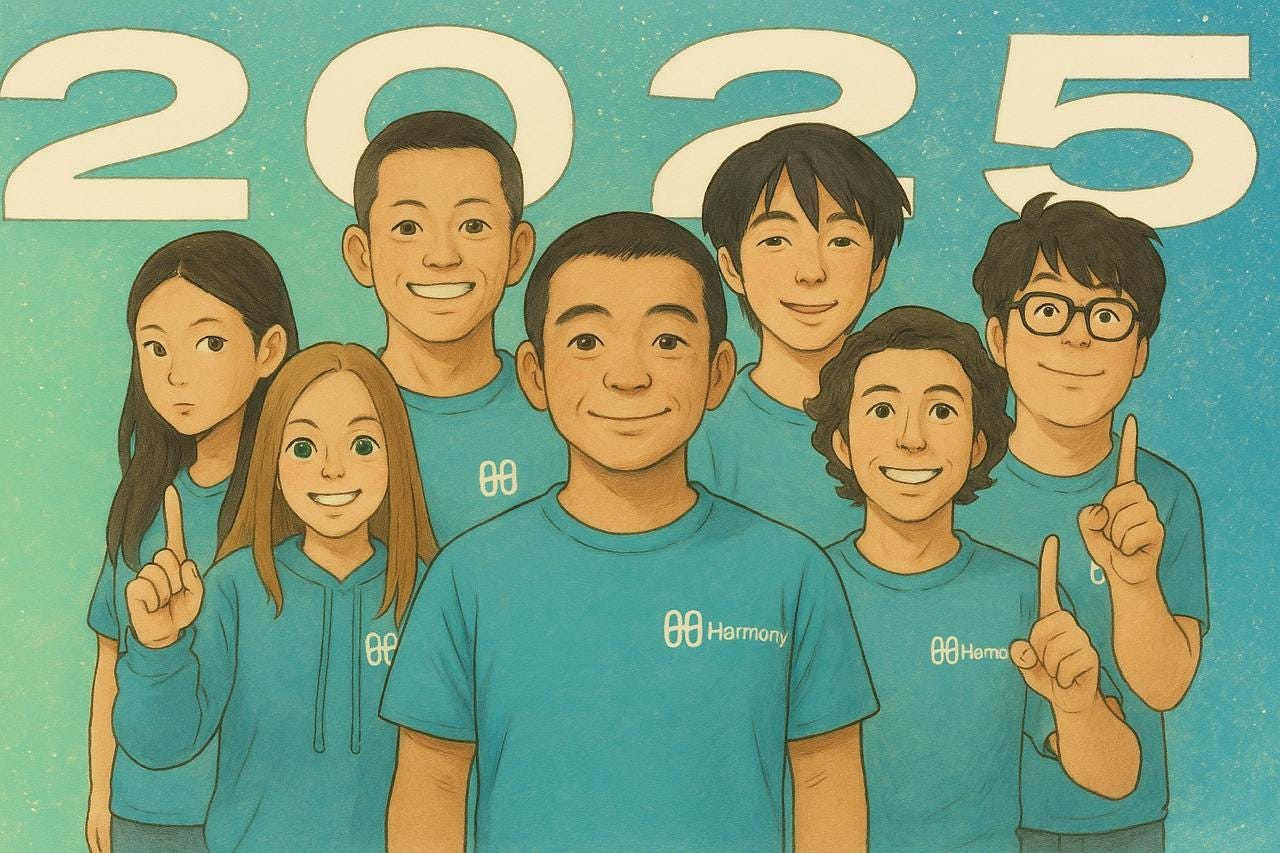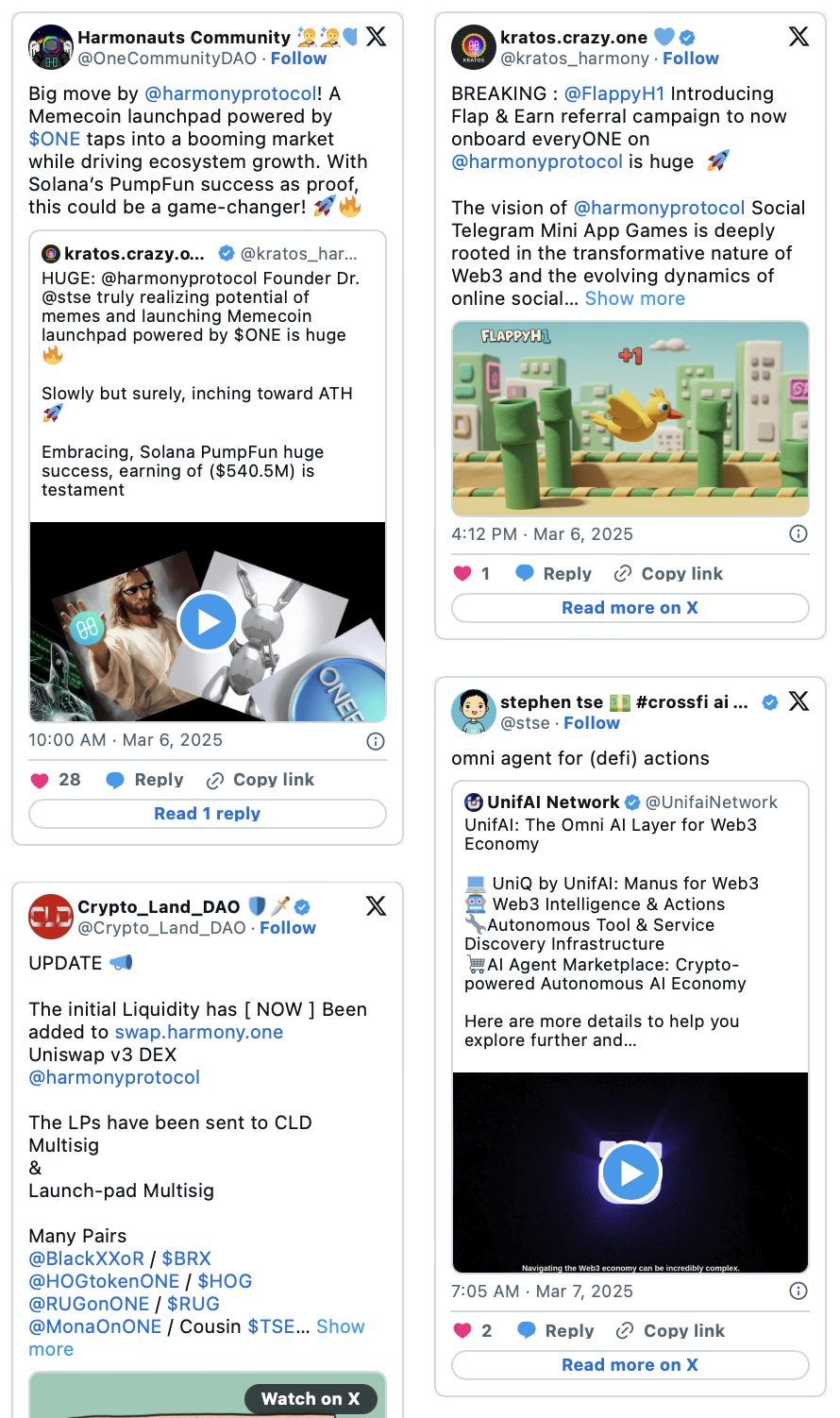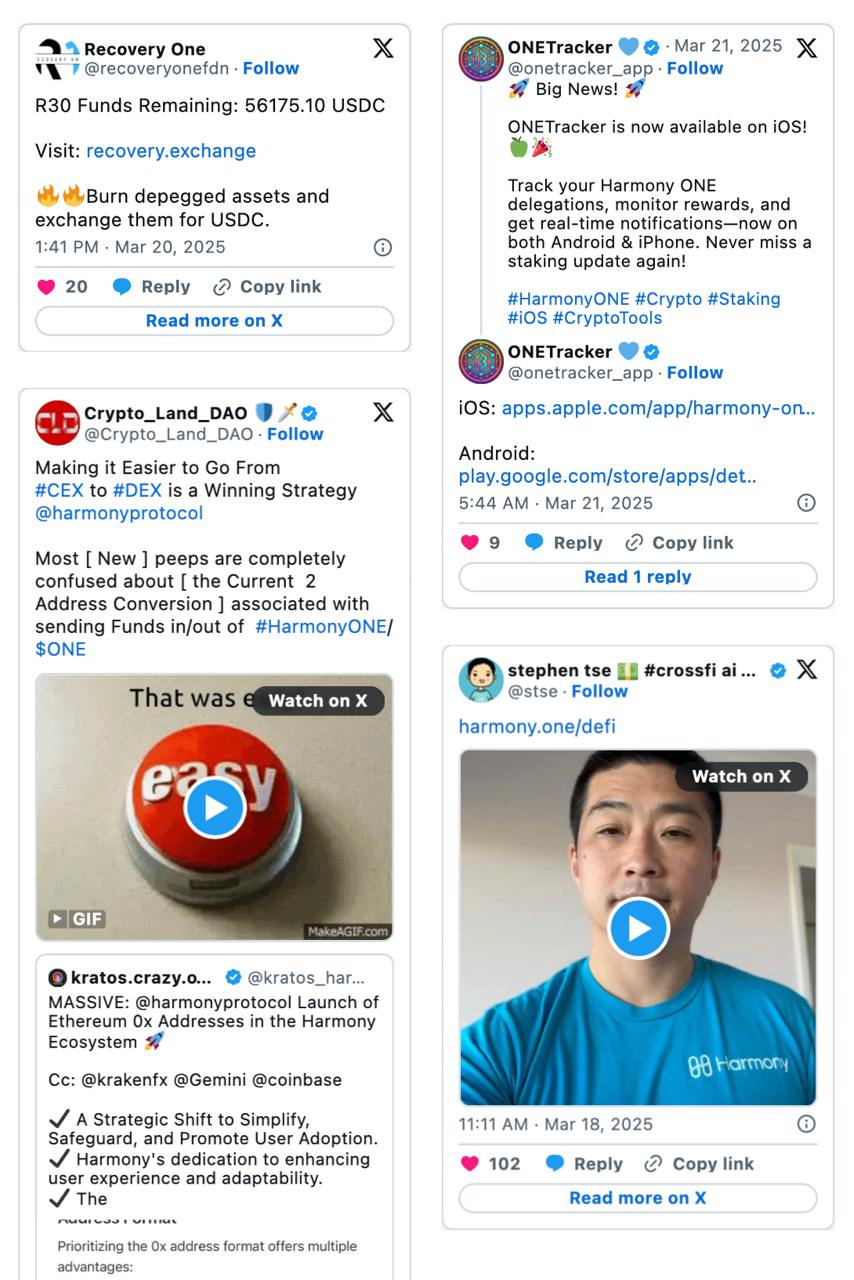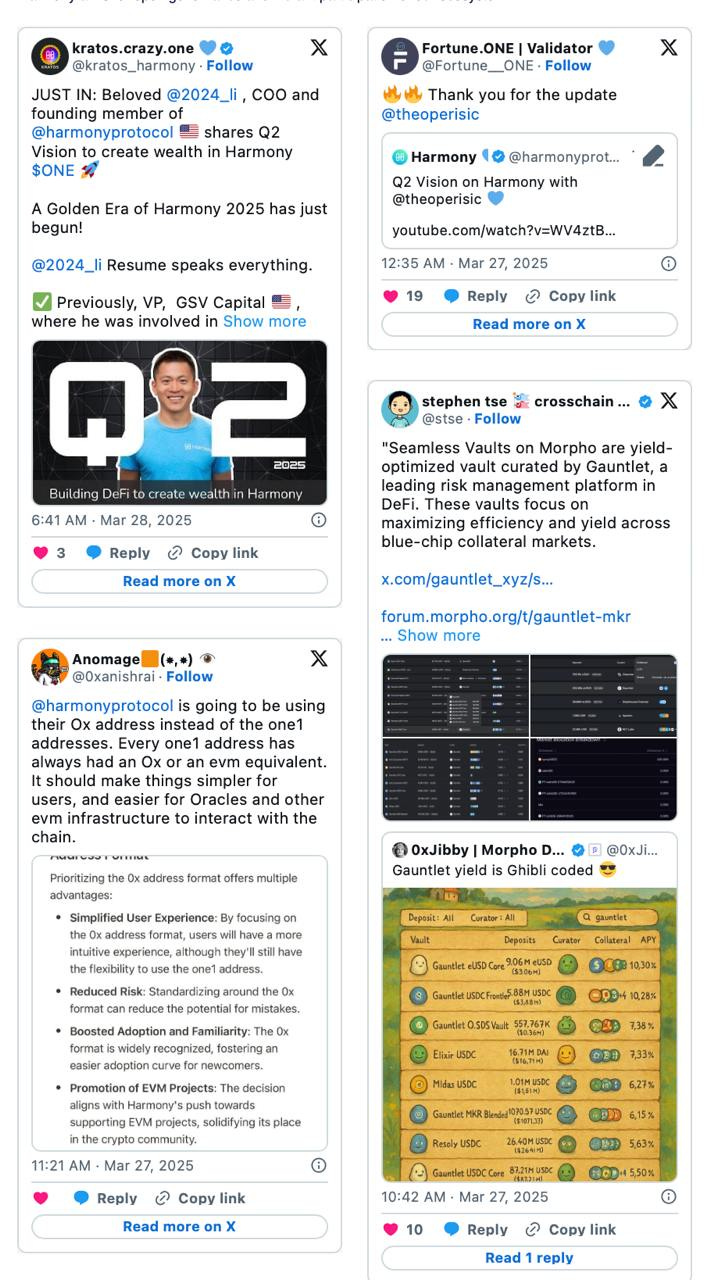Harmony Q1: Cross-Chain DeFi ⛓️, Yield Boost 🔁, Wealth Agent 🧚♂️
In Q1 2025, Harmony significantly advanced its Simple DeFi initiative, undertaking deep technical exploration and foundational infrastructure development. Rigorous testing across diverse protocols including Euler, SwapX, Shadow, Curve, Aave, Beets, Silo, and Magpie provided critical insights into stablecoin lending dynamics, complex yield strategies, and portfolio management pain points. This research directly informed development, including prototyping 1-tick automatic rebalancing algorithms using patched Uniswap SDKs, investigating Loss-Versus-Rebalancing (LVR) for optimized LP strategies, and refining Panoptic options UIs for usability. Key infrastructure milestones included the launch of Pump.ONE, featuring fully upgradable contracts utilizing AccessControl, seamless Uniswap V3 integration via both standard and competition-free factory versions, and critical fixes for Uniswap interactions. Furthermore, the Unify Bridge Assets V1 went live, enabling 1:1 legacy USDC to USDC.e conversion via extended ProxyHRC20 LayerZero contracts, initially supporting Linea and Base networks to combat asset fragmentation. Critical updates to Lend contracts (closefactormantissa, liquidationincentivemantissa) were also implemented to enable liquidations and foster sustainable market health. Foundational work commenced on the LayerZero V2 bridge, designed for dynamic multi-token support and auto-deployment of Harmony-side wrappers, alongside research into automated yield strategies leveraging Gamma and Arrakis models for Sonic deployment.
On the analytics and AI front, Harmony developed crucial internal tooling, including a Python-based DeFi-protocol-TVL-Tracker and the Sonic Yield Calculator, complemented by Shadow Subgraph scrapers and custom Dune SQL queries for accurate, on-chain TVL, APY, fee, and portfolio performance tracking, resolving external API discrepancies. AI capabilities were enhanced through Harmony1Bot's integration of Claude 3.7 Sonnet, DeepSeek, and OpenAI's o1 models, alongside configuring Harmony Agents via Eliza's framework with GitBook integration for autonomous DeFi task exploration. Community engagement and visibility were amplified through targeted product campaigns, securing listings like CoinGecko's 'Made in USA' category and supporting the ONE perpetual futures launch on Kraken, alongside presence at ETH San Francisco and the Stanford Blockchain x AI conference. Concurrently, protocol-level improvements like EIP-1153 (transient storage) and EIP-2718 (typed transactions) were integrated, enhancing network efficiency. These Q1 advancements establish a robust technical and strategic bedrock for delivering intuitive, high-yield Simple DeFi experiences in the coming quarters.
Week of March 1st
In the first week of March, progress was made on auto-rebalancing strategies, loss-versus-rebalancing research, and analytics improvements using platforms like Dune and vfat. Syncing issues in core network components were resolved with fixes to deadlocks and timeout logic, while development on an automated liquidity manager and enhanced data exports continued.
On the ecosystem side, new meme token pairs were added to swap.harmony.one, FlappyH1 launched a referral campaign and UniFAI launched their AI agent.
Top 3 Team Progress
Artem: Built and optimized a comprehensive Shadow exchange data exporter, began researching an automated liquidity manager, and successfully deployed and tested updated UniswapX contracts while documenting the process for the team.
Gheis: I focused on improving syncing stability and performance for StreamNet and Explorer nodes, implementing several critical bug fixes and optimizations. I introduced dynamic timeout adjustments in the advertise function (PR #4846) and fixed a deadlock in the downloader loop by resolving a double-lock issue (PR #4865), which together improved syncing reliability, reduced delays, and enhanced overall network efficiency.
Theo: I explored strategies to bridge the gap between DeFi power users and non-native users, focusing on simplifying platforms like Panoptic and analyzing how to better structure automated LP products. I also ran deep dives on Loss-Versus-Rebalancing (LVR), tested auto-rebalancing with Shadow and x33, refined Dune analytics for accurate performance tracking, and aligned with the team on bridging priorities and product positioning for average vs. power users.
Week of March 8th
In the second week of March, the team completed CL deposit flow with wallet integration and NFT staking, improved stream sync with a new beacon protocol, and progressed EIP-2718 transaction refactors. Subgraph tooling was expanded for accurate Shadow rewards tracking, and modular architecture was built to support Silo and dynamic pool data.
Ecosystem updates included discussion of 0x prioritization and Crypto_Land_DAO announcing a recoveryone burning feature. The team visited ETH SF with the intention of meeting developers for the engineering position outlined on harmony.one/hire.
Top 3 Team Progress
Frank: I built and tested the CL deposit flow for the Sonic Yield Calculator, integrating wallet support, price handling, and NFT staking via Shadow contracts. I also deployed 1Bot with Claude 3.7, improved DeepEeek, and began extracting insights from vfat to support dynamic CL pool tracking. I evaluated DefiLlama but pivoted to subgraphs and scraping for granular pool data. I set up a modular architecture with CLI support and began integrating the Silo protocol.
Aaron: Researched vault strategies, AMM models, and rebalancing mechanisms across protocols like Arrakis, Flying Tulip, and Cosmos-based DeFi. I also investigated xSHADOW incentives and governance, and explored integrations with projects like Socket and deBridge, addressing bridge-related issues and security concerns. I handled domain operations, documented bridge tasks, and tested Sonic vaults.
Gheis: I continued stream sync optimizations and refactoring, deploying PR #4873 to fix a critical epoch sync issue caused by protocol ID mismatches. The update introduces a dedicated protocol for beacon validators, enabling independent epoch sync with stable connections. It was reviewed, merged, and deployed to devnet.
Week of March 15th
In the third week of March, the team advanced the portfolio tracker with Shadow and SwapX support, subgraph integration, and reward/APY calculations. Protocol updates included sync improvements, EIP-2718 progress, and testing for fee optimization and rebalancing strategies using custom analytics tools.
Ecosystem highlights included community discussion of prioritizing Ethereum 0x address support, the launch of the ONETracker iOS app, and the completion of recovery round 30 via Recovery One. Stephen shared Harmony’s Q2 vision shown on harmony.one/defi—Cross-Chain DeFi & Wealth Agents.
Top 3 Team Progress
Artem: Expanded the portfolio tracker and added support for SwapX CL pools, pending rewards from Shadow pools (SHADOW, xSHADOW, X33), and USD value display using the Coingecko API. I also implemented export to TSV, CLI address support, and improved formatting for Excel compatibility. I launched the Shadow subgraph on The Graph, documented the setup process, and began APY/APR calculations for Shadow pools.
Konstantin: Updated 1-second finality feature based on review comments and additional improvements. Passed the review and is expected to be deployed to devnet next week. Updated effective gas price to return a default value of 100 GWEI, preventing potential null values. Reviewed 25% of the PR for the 1.9.25 update, which includes modifications across more than 40 files.
Yuriy: I built scripts to analyze tick ranges, rebalances, trading fees, and rewards across positions, using custom subgraphs and swap data. I also calculated 90% trade volume ranges to identify optimal fee zones and researched linking swap events to position-level rewards. I deployed a custom Shadow subgraph, investigated TVL sources (manual vs. auto-compounded), and refined queries to extract position and reward data. These tools now generate detailed stats for performance analysis and help optimize rebalancing strategies.
Week of March 22nd
In the final week of March, the team improved the portfolio tracker with APR calculations, vault data, and subgraph upgrades for Shadow, SwapX, and Euler. Protocol work included sync fixes, expanded testing, and CI optimizations, while strategy research covered Pendle, Vicuna, and Magpie. The Q1 review was finalized with updated reports and video content.
Ecosystem updates featured continued discussion of Ethereum 0x address support and Q2 vision videos from Theo and Li, focusing on AI wealth agents and cross-chain simple DeFi.
Top 3 Team Progress
Frank: I completed technical documentation on its reward system and event structure. I confirmed rewards are distributed via on-chain PendleGauge contracts and began subgraph research for indexing on Sonic. I also executed and documented test strategies using Aave, Euler, and Magpie, and reviewed DefiLlama limitations on Sonic integrations.
Ulad: I completed two PRs adding test cases for
debug_traceCalland regression tests for the effective gas price fix, now running on each CI cycle. I also began work on optimizing Travis CI to run only on PRs and key branches, aiming to cut wait times in half, and assisted with testing for the Ethereum 1.9.25 dependency update.Theo: I finalized the Q1 review and video, highlighting product updates and deeper DeFi focus. I continued testing vfat.io and Sonic strategies, identifying issues with auto-rebalancing triggers and exploring improvements. I reviewed Euler and Vicuna lending systems, refined the Panoptic UI, and proposed product ideas around automated lending loops and simplified user interactions.
Q1 Team Progress
In Q1, the Harmony team achieved significant advancements in protocol stability, product innovation, and community growth. Below each member highlights their contributions to our protocol, community outreach, and product development.
Protocol & Platform
⛓️Konstantin Potapov
I upgraded the Harmony codebase from Ethereum source version 1.8 to the 1.9 major release, improving EVM internals—including stack management, function handling, and initialization. This PR aligns our codebase with Ethereum, resolving key discrepancies.
I also fixed leader rotation stability in block production, launched 1-second finality on devnet, implemented the BaseFee field in the block header and integrated Ethereum’s EIP-2565 update, upgraded Golang to version 1.24, and improved CI testing for PRs on Travis.
♏️Gheis Mohammadi
During Q1 2025, I focused on improving Harmony’s P2P layer, stream sync, and network stability through multiple optimizations, bug fixes, and new features. Notable improvements include refining stream sync logic, optimizing reconnections, enhancing block request handling, and reducing memory usage. Several PRs addressed syncing inefficiencies, protocol mismatches, and connectivity issues, significantly improving network performance.
Key updates include a new reconnection mechanism for streams, adaptive backoff for peer advertisements, and better error handling for block downloads. I also improved macOS development support by introducing cross-platform builds and streamlined setup instructions. Additionally, major updates to the protocol ID system, epoch sync handling, and explorer node connectivity have enhanced overall network resilience.
Bug fixes included resolving deadlocks, context deadline exceeded errors, and race conditions affecting syncing. With these updates, syncing efficiency, stability, and resource management have greatly improved, making the network more robust and scalable.
Product & Tools
🌻Yuriy Menkov
Improvements and launch of Pump.ONE contracts. All contracts are made upgradable. Added a second alternative version of the Token Factory contract without competitions with the preserved functionality of trading and publishing in Uniswap V3 pools. Transition to AсcessControl with the division of functionality between the roles of administrator and manager. Added utility methods for withdrawing rewards and liquidity. Fixed critical errors in interaction with Uniswap and price calculation. Assistance with integration with backend and frontend services. Support at Pump.ONE application launch.
Completed Unify Bridge Assets V1 feature: USDC converter contract allow converting legacy USDC to USDC.e at a rate of 1-1, extended ProxyHRC20 layerzero contracts to support bridging USDC tokens from different chains to one USDC.e on the harmony side, the frontend was also updated to support unify assets feature. Now the conversion works for the linea and base networks.
Started working on Layerzero V2 bridge contract: one common contract for all tokens, dynamic addition of new tokens via contract method calls, auto deployment of token wrapper on the harmony side. Draft version is ready, currently in debugging stage. Researched options for transferring liquidity from v1 contracts to v2.
Researched contracts for auto balance strategies: vfat Farm Strategy, beefy, arrakis, gamma. Created contract based on FarmStrategy with predefined parameters. The contract checks for range out-of-range and calls rebalancing methods. The goal is to collect statistics for analysis in-range fee-collecting performance in sonic mainnet.
🚎Artem Kolodko
In Q1 2025, I focused on advancing DeFi analytics. I started portfolio performance tracking across Sonic-based DeFi protocols like Silo, Shadow, and Aave, depositing funds and looking for APIs for data aggregation. I completed research on ALM (Automated Liquidity Management) protocols, identifying Gamma as optimal for dynamic volatility strategies, and shared findings with Stephen and Li. Created Shadow Exchange scraper, a set of scripts to export pool's deposits and withdrawals events from the Shadow Subgrarph to CSV, and developed scripts for TVL and APY analysis of Beefy and vfat pools. Additionally, I contributed to Pump.ONE’s client and backend updates, improving competition features and launching production services. I also started researching UniswapX, resolved deployment issues with Aaron's help, and started testing contract deployments on Harmony. My work focused on analyzing DeFi liquidity pools, validating the data, and working with the team on the analysis results.

🧙Frank Egloff
In Q1, I focused on working on DeFi analytics on Portfolio Rebalancing, 1Tick automatic rebalancing, and yield analysis; by developing a Python-based command-line DeFi-protocol-TVL-Tracker with a modular provider-protocol architecture, implementing integrations for Euler, SwapX, Shadow, Curve, Aave, and Beets protocols. I built the Sonic Yield Calculator app to analyze how 1tick automatic rebalancer works, implementing vfat.io functionality using the vfat.tools repository which implements a deposit logic on the Sonic chain. Additionally, I created a Portfolio Management prototype with rebalancing algorithms, using a patched Uniswap SDK and direct contract calls. I provided technical support for Ledger hardware wallet integration, identifying M1/Arm64 architecture compatibility issues.
I enhanced our AI infrastructure by integrating multiple models into Harmony1Bot, including Claude 3.7 Sonnet, DeepSeek, and OpenAI's o1. For the harmony-llm-api, I developed a payment system with ONE balance management and a deposit website built within Flask (not yet live). I configured a Harmony Agent using Eliza's framework with GitBook integration, Telegram client deployment, and created both a Harmony character and Harmonious character with a fun, optimistic tone. I conducted detailed yield analysis for multi-protocol strategies combining Aave, Pendle, and Magpie on the Soniclabs chain.

🧸Alaina Furstenberg
This quarter, I focused on DeFi testing for /wealth, AI-driven content creation, and product marketing strategy. I researched cross-chain swaps, concentrated liquidity, and DeFi rebalancing, documenting my findings on /wealth. I refined my workflow with AI tools like Sora, Pika, and MidJourney, developed detailed marketing plans for five products, and designed animations and graphics for Pump.ONE, exchange.ONE, boostDAI, and other ecosystem initiatives. My content efforts included writing newsletters, generating AI-powered podcast summaries via NotebookLM, and producing Twitter threads covering team progress and ecosystem developments.
On X, I strengthened co-marketing efforts through collaborations with HeyEddie, CryptoLand_DAO, FlappyH1, KrakenPro, and Band Protocol. Q1 performance on X: 895.3k impressions (-7%), 49.6k total engagements (+6%), 18.6k likes (+16%), and 4.1k reposts (+30%).

Community & Development
💹Phillip Petzka
The vision for Harmony to be the Home of Simple DeFi became more structured and detailed, with most of my work contributing to that vision. Q1 was driven by extensive product research focussing on laying the knowledge foundation to develop cross-chain products on Harmony. Users should be able to access yield opportunities across several ecosystems in a simple click and leverage custom strategies on Harmony.
The Yield Enhancer is ready to be launched, and the treasury is accruing yield for it. To enable a better user experience, the bridge infrastructure of Harmony needs to be improved. I built a partnership with Socket protocol to make any asset quickly available via the issuance of wrapped tokens and ensure fast deposits and withdrawals for users. Additional product ideas are evolving around stablecoins, yield product leveraging, and portfolio management.
DeFAI: AI meets DeFi Platforms like @HeyAnonai let users execute trades via chatbots. But will this drive mass adoption?
Crypto’s biggest success stories (pump.fun, Stepn, CeDeFi) simplified UX & promised financial upside. DeFAI offers automation, but it’s still complex—users need deep DeFi knowledge. Can it evolve into a true Web2-friendly experience?
The real test: Is typing a command easier than clicking a button? For DeFAI to onboard the masses, it must abstract complexity like PayPal did for payments.
Abstracting complexity and simplifying DeFi is our mission for 2025. Following along as we build exchange.one, a cross-chain AI portfolio balancer.
⚽️Theo Perisic
I enhanced core DeFi infrastructure by implementing Lend contract updates (closefactormantissa, liquidationincentivemantissa) enabling liquidations and improving stability againts bad debt. I developed the Yield Boost frontend and added details (targeting 15%+ stablecoin APY), contributed code and user-driven strategy to Pump.ONE's dual-launch system, and designed the initial universal bridge UI to eliminate USDC fragmentation into unified USDC.e.
I led the strategic 0x prioritization initiative to resolve our top user onboarding friction point via seamless address compatibility. I researched Loss-Versus-Rebalancing (LVR) for optimized liquidity strategies and built custom SQL queries for accurate on-chain TVL and fee tracking. I resolved CoinMarketCap supply data issues bringing our untracked reporting from 2.65B to 0. Sonic ecosystem analysis led to critical feature potential comparing industry leading rebalancing tools like vfat.io, tracking revealed 50%+ of APY values for various pools come from artificial incentivized yields, confirming a market opportunity for simplified DeFi.
Efforts also boosted Harmony's market presence. Securing the 'Made in USA' category listing on CoinGecko and perpetual futures for ONEon Kraken, further increasing market access.
🌊Sun Hyuk Ahn
In Q1, I implemented EIP-1153, which introduces transient storage opcodes to reduce gas costs and improve smart contract efficiency. I also implemented EIP-2718, which standardizes transaction envelopes, allowing for easier integration of future transaction types. Additionally, I began work on EIP-2930, which introduces access lists to reduce gas costs and improve reliability for certain types of transactions. Alongside protocol work, I began transitioning into the DevOps lead role previously held by Soph. This included managing Ulad, overseeing server infrastructure, system operations, and taking on other critical DevOps responsibilities.
🍓Rikako Hatoya
In early Q1 2025, I worked on AI and mathematics, specifically formal proofs using Lean and testing math Olympiad problems from the minif2f dataset with models from huggingface (AlphaGeometry and DeepSeek Prover). I then shifted to DeFi, researching end-to-end finance and personal on-chain finance tools. This led to hands-on work with asset bridging on Harmony, where I deployed proxy contracts (HRC20 and ERC20, with a lot of help from Yuriy) integrated with LayerZero for assets like AERO.
My main focus has been on the Sonic chain. I began by exploring its ecosystem, researching the highest-yield platforms and pools—primarily SwapX and Shadow. I utilized Dune Analytics, SonicScan, and Graph Explorer to estimate incentives and rewards across pools, and contributed to optimizing allocation strategies. I also tested various dApps within Sonic Labs, investigated farming pools on Silo + SwapX, and experimented with vaults like ICHI + vfat.io.
My most impactful work was developing a repo to extract top profiters from any pool on Sonic—initially focusing on the wS-USDC.e pool on Shadow Exchange through fetching transaction data using SonicScan API. The tool fetches all incentive transactions from a specified rewards gauge (address can be found on Shadow exchange Dune), tracks every interaction (liquidity changes, rewards) between the pool and individual addresses, and computes key metrics like rebalance frequency and APR. This provided valuable insight into the trading strategies of top wallets and can be applied flexibly across pools by modifying the input address.
Q2 Focus
Harmony’s Q2 focus is on delivering Simple DeFi: making powerful, complex DeFi strategies easily accessible through user-friendly products. Building on Q1's research and infrastructure work, Harmony is now moving toward deployment—launching Yield Boost (offering 15–20%+ yields on stablecoins via MakerDAO/Sky Protocol) and integrating AI agentsvia Eliza OS to automate strategies. This quarter also strengthens community-led governance through streamlined DAOs—Transaction, Emission, and Community DAOs—empowering users to allocate protocol rewards toward growth, innovation, or even token burns. With improved onboarding, bridge upgrades, and token creation tools like pump.one, Harmony is positioning itself as the go-to chain for accessible, sustainable DeFi.









